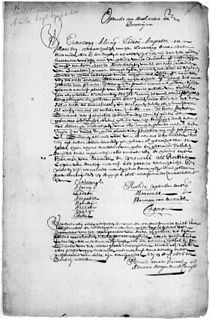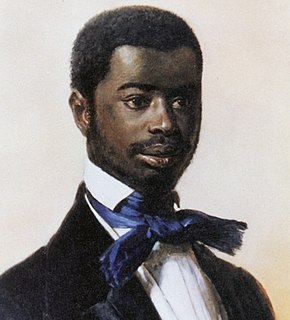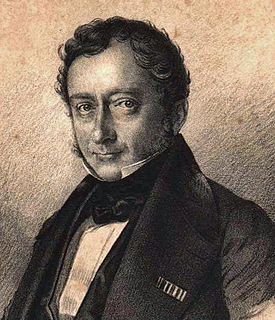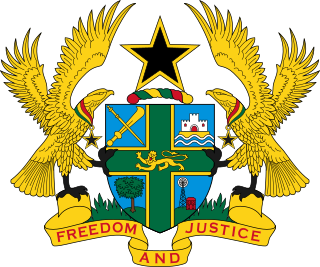
Badu Bonsu II was a leader of the Ashanti and a Ghanaian king who was executed in 1838 by the Dutch, who, at the time, were in control of the Dutch Gold Coast. [1]

Badu Bonsu II was a leader of the Ashanti and a Ghanaian king who was executed in 1838 by the Dutch, who, at the time, were in control of the Dutch Gold Coast. [1]
In 1837, Badu Bonsu II rebelled against the Dutch government, and killed several officers, including acting governor Hendrik Tonneboeijer. The Dutch government used the Treaty of Butre as the basis for military action against Badu Bonsu and an expeditionary force was sent to Ahanta. In the war that followed, the king was captured, sentenced for murder, and hanged. The Dutch disorganised the Ahanta state, appointing their commandant of Fort Batenstein at Butre as regent, keeping the country under close control with an enlarged military and civilian presence. [2] Following the execution of king Badu Bonsu, his body was desecrated as a Dutch surgeon removed his head. The head was taken to the Netherlands, where it was soon lost for more than a century. [3]
The head was rediscovered in the Leiden University Medical Center (LUMC) in the Netherlands by Dutch author Arthur Japin, who had read the account of the head during research for his 1997 novel De zwarte met het witte hart . Japin found the head in 2005, stored in formaldehyde at the LUMC. [4] [5] In March 2009, government officials announced that it would be returned to its homeland for proper burial, [6] [7] a promise fulfilled on July 23, 2009, after a ceremony held in The Hague. [8] [9]

Leiden University Medical Center or LUMC is the university hospital affiliated with Leiden University, of which it forms the medical faculty. It is located in Leiden, Netherlands. LUMC is a modern university medical center for research, education and patient care. Its research practice ranges from pure fundamental medical research to applied clinical research.

The Dutch Gold Coast or Dutch Guinea, officially Dutch possessions on the Coast of Guinea was a portion of contemporary Ghana that was gradually colonized by the Dutch, beginning in 1612. The Dutch began trading in the area around 1598, joining the Portuguese which had a trading post there since the late 1400s. Eventually, the Dutch Gold Coast became the most important Dutch colony in West Africa after Fort Elmina was captured from the Portuguese in 1637, but fell into disarray after the abolition of the slave trade in the early 19th century. On 6 April 1872, the Dutch Gold Coast was, in accordance with the Anglo-Dutch Treaties of 1870–71, ceded to the United Kingdom.

The Treaty of Butre between the Netherlands and Ahanta was signed at Butre, Dutch Gold Coast on 27 August 1656. The treaty regulated the jurisdiction of the Netherlands and the Dutch West India Company over the town of Butre and the surrounding country of Upper Ahanta, creating a Dutch protectorate over the area. The treaty lasted until the Dutch departure from the Gold Coast in April 1872.

The Treaty of Axim was concluded between the Netherlands and the chiefs of Axim in the western region of the Gold Coast and signed at Fort St. Anthony near Axim on 17 February 1642. The treaty regulated the jurisdiction of the Netherlands and the Dutch West India Company in the town and polity of Axim after the Dutch West India Company had successfully attacked the Portuguese who were the occupants of Fort St. Anthony in the town. Over time, the agreement was in part superseded and replaced by new contracts and agreements. The treaty did remain the basis for Dutch jurisdiction and political relations between Axim and the Dutch until the latter left the Gold Coast in 1872.
The Ahanta/Ayinda are Akan People who live to the north and east of the Nzema. The Ahanta land has been historically known as one of the richest areas on the coast of what is now Ghana.

Fort Saint Anthony was a fort built by the Portuguese in 1515 near the town of Axim, in what is now Ghana. In 1642, the Dutch captured the fort and subsequently made it part of the Dutch Gold Coast. The Dutch expanded the fort considerably before they turned it over, with the rest of their colony, to the British in 1872. The fort is now the property of the Ghanaian state and is open to the public.

Kwasi Boachi was a Prince of Asanteman who was sent to the Netherlands together with his cousin, Kwame Poku, in 1837, by his father, King Kwaku Dua Panin, to receive education as part of larger negotiations between the Ashanti and the Dutch about the recruitment of Ashanti soldiers for the Dutch East Indies Army.

The Two Hearts of Kwasi Boachi is the 1997 debut novel by Dutch author Arthur Japin. The novel tells the story of two Ashanti princes, Kwame Poku and Kwasi Boachi, who were taken from what is today Ghana and given to the Dutch king William II in 1837 as a surety in a business transaction between the Dutch and Ashanti kingdoms. The two boys are raised and educated in the Netherlands, after which Kwame returns to Africa while Kwasi continues his education in Weimar Germany and then takes a position in the Dutch East Indies. The novel is a postcolonial depiction of the Dutch colonial past. It quickly became a bestseller and was translated worldwide, and is now considered a classic of Dutch modern literature.
Pieter Woortman was a slave trader and an administrator of the Dutch West India Company. He was one of the longest-serving Director-General of the Dutch Gold Coast, in office between 1767 and 1769 and from 1769 until his death in 1780.
The Dutch–Ahanta War was a conflict between the Netherlands and the Ahanta between 1837 and 1839. Beginning with a mere economic dispute between the Ahanta and the Dutch, who were based at the Dutch Gold Coast, the conflict ended with the hanging of Ahanta king Badu Bonsu II and the reorganization of the Ahanta state, establishing a Dutch protectorate over the Ahanta.
Hendrikus Jacobus Tonneboeijer was a Dutch colonial officer, who made a career in the administration on the Dutch Gold Coast. He was Acting Commander of the Dutch Gold Coast in 1836 and 1837.
The Treaty of Asebu was concluded in 1612 between the Dutch Republic and the chiefs of Asebu on the Gold Coast of Africa. The treaty was the first among several concluded between the Dutch and the peoples of the Gold Coast, and marked the beginning of a 260-year period of Dutch presence on the Gold Coast.
George Emil Eminsang was a prominent Euro-African merchant and political leader on the Gold Coast, who played a prominent role in the last years of Dutch colonial rule on the Gold Coast. After the Dutch Gold Coast was transferred to the United Kingdom, Eminsang became a diplomat for the Netherlands and later for the United States and the Congo Free State. Together with James Bannerman Hyde and James Hutton Brew, Eminsang was one of the first so-called "country lawyers" on the Gold Coast.
Anthony van der Eb was a Dutch civil servant, who made a career in the administration on the Dutch Gold Coast.

Christiaan Ernst Lans was a soldier in the Royal Netherlands Army who eventually became the colonial head of the Dutch Gold Coast in 1834. He served until 1836 and returned to the Netherlands afterwards.
Jan Verveer was a major general of the Royal Netherlands Army.
The Kingdom of the Netherlands has an embassy in the Republic of Ghana. It has a role in promoting trade between the countries.
Pieter Simon Hamel was a Dutch diplomat who served as Consul General at Elmina, Bangkok and Amoy.
Willem Pieter Antonie Le Jeune, born as Willem Pieter Antonie Tenwinkel, was a Dutch colonial administrator and diplomat, who made a career in the administration on the Dutch Gold Coast and who was interim governor between 28 October 1871 and 15 November 1871. After the Netherlands sold its possessions on the Gold Coast to the United Kingdom in 1872, Le Jeune became the first Dutch consul in Elmina.

The Political history of Ghana recounts the history of varying political systems that existed in Ghana during pre-colonial times, the colonial era and after independence. Pre-colonial Ghana was made up of several states and ethnic groups whose political system was categorized by 3 main administrative models; Centralized, Non-centralized and Theocratic states. In the colonial era, the British Empire employed different forms of government among its four territorial possessions in the Gold Coast. Indirect rule was implemented in the late 19th century after its success in Northern Nigeria. From the 1940s, native Ghanaians yearned for more autonomy. This resulted in the several constitutional reforms as well as the creation of the office of the Prime Minister in 1952.